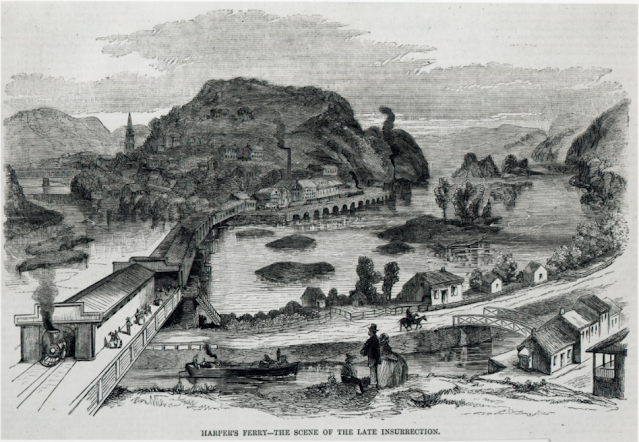Preserving the Old Line: C&O Canal National Historical Park marks 50 years
By: Chris Craig
 |
This 1859 Harper’s Weekly illustration depicts the canal (foreground) and the covered bridge which connected Maryland and then-Virginia. The bridge was first destroyed during a Confederate evacuation of the town on June 14, 1861. It would be destroyed and rebuilt nine times during the war. (From the Towpath Guide to the C&O Canal, HFHA, 2012. Image courtesy National Park Service, Harpers Ferry National Historical Park, Historical Photograph Collection, Catalog #HF246)
One of the things that makes Jefferson County a great place to live or visit is its proximity to national parks. One of these, the Chesapeake and Ohio Canal National Historical Park, turns 50 years old on January 8. And though this long park/towpath lies across the Potomac River in Maryland, its impact on West Virginia’s economy, recreation, and history is immense.
West Virginians in large numbers use the C&O Canal NHP to hike, bicycle, or paddle. They eat, drink and shop in Canal Towns, enjoy scenic views, and take pleasant drives along adjacent backroads. In 2019, Harpers Ferry was the busiest entry point along the towpath’s 184 mile route, eclipsing even Georgetown or Great Falls. This intersection of two national parks has benefited visitors and merchants, and created enduring partnerships with the shared mission of protecting these treasured places.
Historically, the canal’s direct impact on what is now West Virginia began in 1833 when the C&O Canal opened and commenced service just across the Potomac from Harpers Ferry, winning its race with the B&O Railroad to that location by one year. Construction and operation of the Canal brought new capital and an influx of Irish laborers and other new residents. Manufacturing and trade upstream in Shepherdstown boomed a couple years later when a cement plant and grain warehouse along the canal made that town one of the busiest along the route.
 |
Increased trade and transportation meant new links with Washington and the industry and population centers downstream. And though the C&O’s impact would soon be eclipsed by a rapidly expanding network of B&O and other rail lines, the canal would continue to provide transport for charcoal, agricultural goods, and later coal.
Still, the canal’s riverside path made it vulnerable to the ravages of frequent flooding that affected towns along the Potomac. The cycle of damage and reconstruction led the company into bankruptcy after the great flood of 1889. And another flood in 1924 proved so extensive that it wasn’t worth the repair necessary to reopen the aging transportation system. The old line lay fallow for nearly a half century.
During the Great Depression, the National Park Service gained ownership of the C&O corridor and eventually devised a plan to turn it into a motor parkway—think Skyline Drive or George Washington Parkway. Conservationists, however, had other ideas. Members of the Audubon Society, Wilderness Society and National Parks Association banded together to promote the idea of a linear nature park that could be used by hikers, bicyclists and canoeists. They found a champion in Supreme Court Justice William O. Douglas.
In addition to his long and influential service on the Court, Douglas was an environmentalist and outdoorsman. He served on the Sierra Club’s Board of Directors, hiked the entire Appalachian Trail, and wrote extensively to preserve wild lands and rivers. As a frequent hiker on the C&O Canal towpath, he saw the value in preserving the corridor as a natural park. In March 1954 he enlisted journalists and others to join him in a walk of the entire towpath, hoping that through their reporting the public would become acquainted with the nature and history of the C&O. Largely as a result of a groundswell of support generated by the hike and the subsequent sympathetic editorials in the Washington Post, the Park Service would establish the C&O Canal National Historical Park in January 1971.
Given that we’ve had 50 years to enjoy walks, bike rides and exploration of history and nature along the towpath, it seems fitting that we celebrate the C&O’s anniversary with a year-long celebration. Jefferson County Convention and Visitor’s Bureau will be joining with the Maryland Office of Tourism and towns along the C&O to mark the birthday with special recreational and educational events and the World Canal Conference (Aug. 30-Sept. 2, Hagerstown).
Although plans for some town-sponsored events remain tentative due to COVID protocols and concerns, a brewery trail, ice cream trail and specialty sandwich trail are in the works, and hotels, outfitters, and merchants will have special offers to encourage visitors to share in the “C&O Canal Experience” with short and extended trips. A juried photo contest and exhibit is being planned, and warmer weather may bring inter-town hikes and bike rides. Keep an eye out for the fun at www.canaltrust.org/50th.
* * *
Author Bio: Christopher Craig first fell in love with Harpers Ferry in 1984 while on a long-distance bicycle tour. In 2005, he made the move to full-time residency in his favorite town, and he operated a bed and breakfast in his historic home for nearly 10 years. Chris became immersed in the history of Harpers Ferry through reading, attending programs, and researching the history of his house. Prior to his innkeeping, Chris was a high school teacher for 20 years. Now a Harpers Ferry Certified Park Guide, he also serves as a volunteer editor and officer in various professional, non-profit and community organizations. He continues to enjoy the outdoors in and around his home, and last year he began a series of section hikes on the Appalachian Trail, which he hopes to complete by 2026.

.jpg)
Comments
Post a Comment